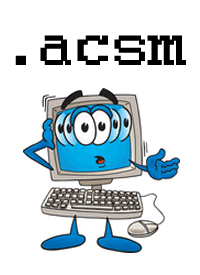Burning eBooks
 Ray Bradbury’s classic dystopian novel Fahrenheit 451 has recently been released as an ebook by Simon & Schuster (available online Fahrenheit 451 ebook). The novel is about a future in which most books have been burned in order to keep the public “happy”. A world without books and the resulting lack of readily available knowledge and history is bleak indeed.
Ray Bradbury’s classic dystopian novel Fahrenheit 451 has recently been released as an ebook by Simon & Schuster (available online Fahrenheit 451 ebook). The novel is about a future in which most books have been burned in order to keep the public “happy”. A world without books and the resulting lack of readily available knowledge and history is bleak indeed.
Ray Bradbury himself was against ebooks at first, saying that they were too distracting. From this article at The Guardian:
“In the past Bradbury has said that ebooks ‘smell like burned fuel’, telling the New York Times in 2009 that ‘the internet is a big distraction’. In an interview … he told the paper that he had been contacted by Yahoo eight weeks earlier. ‘They wanted to put a book of mine on Yahoo! You know what I told them? To hell with you. To hell with you and to hell with the internet. It’s distracting. It’s meaningless; it’s not real. It’s in the air somewhere.’
But the author has now been convinced otherwise, with his American publisher Simon & Schuster announcing that it was releasing the first ever ebook of Fahrenheit 451, a novel which has sold more than 10m copies since it was first published in 1953 and in which Bradbury predicts a dystopian future where books are burned and reading banned.”
I’m glad that we don’t live in a future like that described in Fahrenheit 451 and I think that digital books and the internet in general will make it very hard, if not impossible, for the government to ever truly ban books or other reading material. When I read this book back in middle school, I visualized police overseeing large piles of burning books in the middle of town squares, while people looked on with blank expressions. I wonder what would happen if anyone ever tried to burn a pile of e-readers. The resulting melted pile of plastic would surely be enough of a mess that the government would have to find some other way to destroy books. Maybe that’s why Bradbury imagined that ebooks smelled like burned fuel?
Best eBook Apps for Android
The best Android ebook app for you mostly depends on where you want to buy your ebooks. Each ebook app works for a specific type of ebooks, so you need to match up the type of ebooks you own to the type of app you need. The apps below are the most popular for Android users and cover most main ebook sources that people use today.
 Aldiko
Aldiko
The Aldiko Android App is the best alternative to apps from big ebook sources (like Kindle or Nook) because it allows you to read PDF and ePub ebooks from independent ebook sources. It supports Adobe DRM and non-DRM ebooks, so you can read ebooks that you purchased at places like ebookmall.com, ebooks.com, or diesel-ebooks.com. You can also import your own content and create your own ebook catalogs.
Download: You can get a direct download from Aldiko.com or find Aldiko in the Google Play Market.
Android OS Version Supported: Android OS 2.1 or higher
eBooks Supported: The Aldiko Book Reader supports Adobe-DRMed ePub and PDF as well as non-encrypted ePub and PDF formats. Get eBooks anywhere ePub and PDF eBooks are sold or available for free. You can also get ebooks from your public library (where supported).
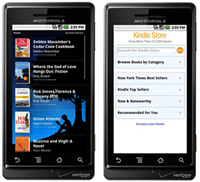 Amazon Kindle Android App
Amazon Kindle Android App
The Kindle App for Android lets you read all of your Kindle ebooks on an Android device, even if you don’t own a Kindle eBook Reader. If you do have a Kindle, you can read your ebooks on both the Kindle and Android device. Your reading progress will be synced between the devices with Amazon’s “Whispersinc”. You can use the Kindle Android app to borrow ebooks and view free samples.
Download: Go to the Kindle for Android page on Amazon. Or, while on your phone you can search for “Kindle” in the Google Play market.
Android OS Version Supported: Android OS 2.2 or higher
eBooks Supported: Amazon Kindle ebooks in the AZW format that are only sold at Amazon.com/Kindle
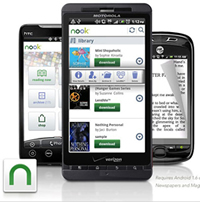 Barnes & Noble Nook Android App
Barnes & Noble Nook Android App
The Android Nook App from Barnes & Noble lets you read all of the Nook ebooks on your Android device without having to own a Nook eBook Reader. Nook for Android gives you access to over 2 million books, magazines, and newspapers. You can try newspapers and magazines for free for 14 days and sample lots of Nook ebooks for free. You can also start reading an ebook on one device and continue at the same place on another device.
Download: Get the Android app at B&N’s Nook for Android page by scanning the barcode shown with your phone. Or search for “NOOK” in the Google Play market.
Android OS Version Supported: Android OS 2.1 or higher
eBooks Supported: If you want to read ebooks using the Nook App, then you should get ebooks from Barnes & Noble’s Nook store.
 Kobo Android App
Kobo Android App
With the Kobo Android app, you can buy ebooks from inside the app and download them directly to your phone. Take your entire library with you on the go. You can find all of your favorite titles and authors in Kobo’s large ebook selection of over 2.5 million books. You can also get personalized recommendations.
Download: Go to the Kobo Android App webpage to scan the QR code. Or search Google Play for Kobo.
Android OS Version Supported: Android OS 1.6 or higher
eBooks Supported: If you want to use the Kobo Android app, you should download eBooks from the Kobo eReader store.
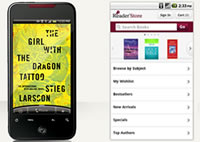 Sony Reader Android App
Sony Reader Android App
The Sony Reader Android app comes pre-loaded with three classic titles and three excerpts from bestselling ebooks. You can sync your reading position, bookmarks, and highlights to Reader Daily Edition (PRS-950SC with firmware 2.0). Like the other apps, you can also read Sony Reader ebooks even if you don’t have a Sony Reader.
Download: Go to the Sony Reader for Android webpage and scan the QR code. Or, search for the app in the Google Play market.
Android OS Version Supported: Android OS 2.2 or higher
eBooks Supported: If you want to read Sony Reader ebooks on your Android device, get them from Sony’s Reader Store.
3 Interesting Infographics About eBooks
Here are three interesting infographics about eBooks.

Courtesy of: CreditDonkey
Small Update on the Price Fixing Lawsuit
It kind of seems like this whole thing with the lawsuit over price-fixing of ebooks has just been blowing about in the ether lately. I found a small update today, though. From this post at the Guardian:
Apple and five major book publishers have failed to persuade a US judge to throw out a lawsuit by consumers accusing them of conspiring to raise electronic book prices two years ago. …
HarperCollins, Simon & Schuster and Hachette reached settlements, while Apple and two of the publishers, Macmillan and Penguin, said in court last month they want to go to trial to defend themselves against the government charges.
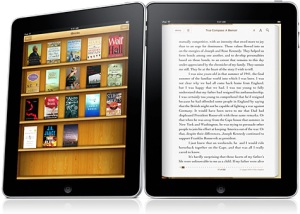 So the only real update I’ve heard so far is that they won’t be throwing the case out. It sounds like HarperCollins, Simon & Schuster and Hachette must have had to pay a fine, while Apple, Macmillan, and Penguin want to go to trial. The end result of that trial will be fairly important for the publishing industry. This article on The Atlantic does a good job of explaining the whole thing: Confused By the eBook Lawsuit? So Is Everyone Else
So the only real update I’ve heard so far is that they won’t be throwing the case out. It sounds like HarperCollins, Simon & Schuster and Hachette must have had to pay a fine, while Apple, Macmillan, and Penguin want to go to trial. The end result of that trial will be fairly important for the publishing industry. This article on The Atlantic does a good job of explaining the whole thing: Confused By the eBook Lawsuit? So Is Everyone Else
On one hand, it appears that the publishers who were involved with this alleged price fixing were breaking the law insofar as that you’re not supposed to team up with your competitors to decide on industry-wide prices. On the other hand, they were attempting to prevent Amazon from becoming an ebook monopoly. I’m no lawyer and I don’t really understand all of the technical details of this stuff, but it will certainly be interesting to see what happens in this trial.
I think that if I were running a big publishing company, I would just try to sell my books at the same price at each store, and then let the customer decide which store and ebook platform they wanted to use. That kind of thing shouldn’t be so difficult, and I hope that in the end things will be simpler for the consumer.
How To Open .acsm Files
ACSM files (files that end with .acsm) often cause confusion for those who are unfamiliar with them. This post will tell you what you need to do to open them.
Basic Information
- ASCM files are part of Adobe’s eBook DRM.
- ACSM files are not supposed to be the full eBook. They are small files that manage the download of the eBook.
- ACSM files are made to be opened with Adobe Digital Editions. This is a free program from Adobe that was created for their eBook DRM. Get it here.
- To open an ACSM file, simply double-click it, and it should open in Adobe Digital Editions if you have that program installed.
- Opening the ACSM file in Adobe Digital Editions will allow it to continue your eBook download. When it’s finished you’ll have a PDF or ePub file.
Advanced Information
Authorization
If you’re downloading an .acsm file, it’s probably an eBook with DRM, so you should also make sure that Adobe Digital Editions is properly authorized. I have a post that explains this process for you. Authorizing your copy of Adobe Digital Editions with an Adobe ID will allow you to use your eBook on more than one computer as well as your mobile devices that support Adobe’s DRM.
ACSM files on iOS, Android, or eReaders
Sometimes people will try to download a DRM-protected PDF or ePub directly to their iPhone/iPad/eReader/Android device. That won’t work because the .acsm file can’t be opened in any apps on those devices. The eBook must be downloaded to your computer first, through Adobe Digital Editions. There is no version of Adobe Digital Editions for iOS, Android, or eReaders. After you’ve downloaded the ebook to your computer, you can then transfer it to your device.
Convert .acsm to PDF?
Often when people are unfamiliar with .acsm files they think they should convert the file to a PDF. This is not possible, and it arises from the mistaken assumption that the .acsm file is the eBook and they’ve somehow downloaded a weird file type. If you have an .acsm file, the only thing you can do is open it with Adobe Digital Editions. That will continue the eBook download process, and once that’s finished, you’ll have your PDF/ePub file.
File Associations
It’s easy for your computer’s file associations to get messed up when you try to open a file in the wrong program. If you’ve downloaded an .acsm file and you tried to open it in, for example, Adobe Reader or Adobe Acrobat, you might have checked the little box that says “Always open files of this type in this program”. If you did that, you’ve screwed up your file associations and .acsm files will always try to open themselves in the wrong program.
To fix this, you’ll need to edit your file associations. Instructions on now to change file associations on a Mac | Instructions on now to change file associations on Windows Vista & 7
How To Open ACSM Files
There are always three ways to open a file on your computer:
1. Double-click it. It will open in the program that your computer has associated with that file type. See above if you’ve associated .acsm files with the wrong program.
2. Right-click it. Right-click the file, go to “Open With”, and choose Adobe Digital Editions.
3. Open manually from inside the program. Open Adobe Digital Editions. In the upper left area, find LIBRARY. Click the downward arrow next to Library, and click on “Open”. Find the file on your computer. It should be in a folder called My Digital Editions, which is in the main Documents folder.
…
Get some free ebooks!
Major Publishers Being Sued Over the Agency Model
The United States Department of Justice is suing Apple along with publishers Hachette SA, HarperCollins, Macmillan, Penguin, and Simon & Schuster, for conspiring to raise the prices of ebooks. This article at PC World does a pretty good job of explaining the basics of the situation. Here’s the core of it:
At issue is Apple’s use of the “agency” model of e-book pricing, which lets publishers set their own prices. Apple takes a 30 percent cut of sales, but requires that e-books are sold for no cheaper elsewhere. That approach came into conflict with the “wholesale” model used by Amazon, where the bookseller pays roughly half the recommended cover price, then sets its own pricing.
With the wholesale model, Amazon could offer cut-rate prices on e-books — often $10 for bestsellers — in order to build up its Kindle service. When Apple launched the iPad in 2010, publishers flocked to the agency model, fearing that the wholesale model would lead to a race to the bottom in pricing. Amazon was forced to adopt the agency model, and today, a $10 bestseller is much harder to find. New books tend to sell for around $13 to $15 instead.
Apple and publishers may argue that the agency model leveled the playing field for booksellers, forcing them to compete on hardware and software features instead of pricing. And as Bloomberg points out, e-book sales rose 117 percent in 2011, so it’s hard to argue that higher prices ruined the digital book industry. source
 Opinions on this could go either way, but if there really was a conspiracy by the big publishers to raise prices, that would be against the law. This is a big enough story that they even talked about it on the Nightly News with Brian Williams tonight. From my position as someone who works in this industry, it’s all kind of surreal because for the longest time ebooks were overlooked and not taken seriously. Now they’ve become popular and mainstream enough that there are serious legal issues being considered. I also know that the agency model created major headaches for independent ebook sellers, so for that reason it would be kind of nice if it was deemed illegal. However, I can also understand that from a publisher’s point of view, Amazon’s price cutting is very scary for them.
Opinions on this could go either way, but if there really was a conspiracy by the big publishers to raise prices, that would be against the law. This is a big enough story that they even talked about it on the Nightly News with Brian Williams tonight. From my position as someone who works in this industry, it’s all kind of surreal because for the longest time ebooks were overlooked and not taken seriously. Now they’ve become popular and mainstream enough that there are serious legal issues being considered. I also know that the agency model created major headaches for independent ebook sellers, so for that reason it would be kind of nice if it was deemed illegal. However, I can also understand that from a publisher’s point of view, Amazon’s price cutting is very scary for them.
I wonder what actually happened. I remember that Amazon offered most Kindle ebooks for $9.99 in the beginning, and that suddenly stopped once Apple started requiring that publishers couldn’t sell their ebooks for a lower price than the price they set for iBooks downloads. But was that the only thing? Was it solely Apple’s decision, or was there some kind of secret meeting between publishing executives where they sat in a dark room around a table and agreed to raise ebook prices? The truth is probably something in between. It’ll be very interesting to see what comes of this and how it affects ebook prices and publishing in the future.
Harry Potter eBooks
The big ebook news this week is that official Harry Potter ebooks are now available on the Pottermore website.
When I read about this, the first thing I wondered about was what format the ebooks were being made available in, and what kind of DRM they were using. From looking at their supported devices FAQ page, at first it appeared that they were using typical Adobe DRM, since they mention the use of Adobe Digital Editions.  However, it seems to be more complicated than that. In order to get ebooks onto a Kindle, for example, they’ve somehow set it up so that you link your account so that the ebook can be delivered to your Kindle. The same goes for your Sony Reader, Nook, or Google Play accounts. Additionally you can download an ePub to your computer. It also appears that you can transfer the ePub to other eReaders with ADE in the same way I’ve outlined on this blog before.
However, it seems to be more complicated than that. In order to get ebooks onto a Kindle, for example, they’ve somehow set it up so that you link your account so that the ebook can be delivered to your Kindle. The same goes for your Sony Reader, Nook, or Google Play accounts. Additionally you can download an ePub to your computer. It also appears that you can transfer the ePub to other eReaders with ADE in the same way I’ve outlined on this blog before.
There seems to be more to it, though. Apparently when these ebooks were first announced, the people behind Pottermore claimed that the ePubs would be without DRM. Now it’s become clear that there is some kind of DRM on them, which people are calling “watermarking”. I’ve never even heard of that term being applied to DRM. The Digital Reader has a post about this DRM method and how it was already hacked.
This article on The Guardian is quite interesting. It talks about how Pottermore has managed to force Amazon to bend to its will.
“Instead of buying the ebooks through the Amazon e-commerce system, the buy link takes the customer off to Pottermore to complete the purchase, with the content seamlessly delivered to their Kindle device. It is the first time I’ve known Amazon to allow a third party to “own” that customer relationship, while also allowing that content to be delivered to its device. Amazon gets something like an affiliates’ fee from this transaction, much less than it would expect to receive selling an ebook through normal conditions.”
This is very unlike usual Amazonian practices. I assume it’s because Pottermore wouldn’t allow them to sell the ebooks in any other way, and it shows how much power the Harry Potter brand has. There is another article at FUTUReBOOK by the same author that delves more into this Amazon situation and how DRM is applied across different platforms. The whole system must have been a pretty big undertaking for all companies involved.
All in all, it’s cool to see that there are now official Harry Potter ebooks because that only enforces the idea that ebooks are here to stay, in one form or another. I probably won’t buy them myself since I already own the whole series in old-fashioned paper. Will you?
Recent Stories of Piracy and Plagiarism
eBook piracy and plagiarism are two of the worst fears of authors and publishers. Just like with music and movies, there are now websites that offer many pirated ebook downloads. Plagiarism has been happening for ages and it’s only become easier with books in digital format.
This article on The Guardian paints a new picture for plagiarists, though. Even though it’s easier to copy the contents of an ebook, it’s also easier to get caught now that everything can be scrutinized online. This article is about an author who discovered someone ripping off many of her romance books, only changing major details like names and places. After one instance was discovered, others joined the author in researching the plagiarist’s work, and more and more cases were quickly found. The plagiarist was outed online and forced to pull her stolen work.
In this age of blogs and Twitter, a reputation can be ruined pretty easily. It seems to me like all the trouble of trying to plagiarize isn’t even worth it. If you’re interested in being an author, write your own stuff. If you don’t have any talent for writing then find something else to do.
Piracy is probably the bigger threat since it doesn’t require any work like editing details of the story. Instead, all a person has to do is strip the DRM (if it even exists in the first place). Recently one company was caught selling $99 e-readers pre-loaded with 4000 pirated ebooks. From the article:
An Australian group-buying site owned by Microsoft and Nine sold e-book readers bundled with a treasure trove of thousands of pirated books including the full Harry Potter and Lord of the Rings series.
The matter has prompted a rebuke from the NSW Fair Trading Minister, Anthony Roberts, who claims group-buying sites cannot simply blame vendors when they are caught running dodgy deals.The book industry has reacted angrily and HarperCollins, publisher of some of the major titles contained on the CD including those by J.R.R Tolkien, said its corporate solicitor ”will be ringing them today”.
The site, Cudo.com.au, this week advertised a $99 e-book reader that came with ”4000 e-books you can load from a CD”. Thousands of people signed up for the deal, but the company claims it discovered the books were pirated before orders were shipped.
Cudo’s advertisement originally linked directly to a list of books that came on the bonus CD, and the list contained thousands of books that were still under copyright and available in stores. The site later removed this link from the advertisement, but the original ad is still visible in Google’s cache.
”It’s extraordinary … there’s piracy taking place on a grand scale,” said Australian Booksellers Association chief executive Joel Becker when shown the list of books.
Whether you hate or just tolerate DRM, most publishers will continue to require it as long as they feel that their ebooks will be pirated without it. It’s unfortunate that the average law-abiding user is the one who gets punished by having to deal with DRM restrictions. Authors deserve to get paid for their work just like everyone else, though, so what are they supposed to do? And this time there won’t be another iTunes that comes along and sort-of-transforms the situation like they did with MP3s, because we already have Kindle software and iBooks and other paid ebook services. Unless all of humanity suddenly comes to a state of enlightenment where nobody wants to steal anymore, I don’t know how pirating will ever stop.




